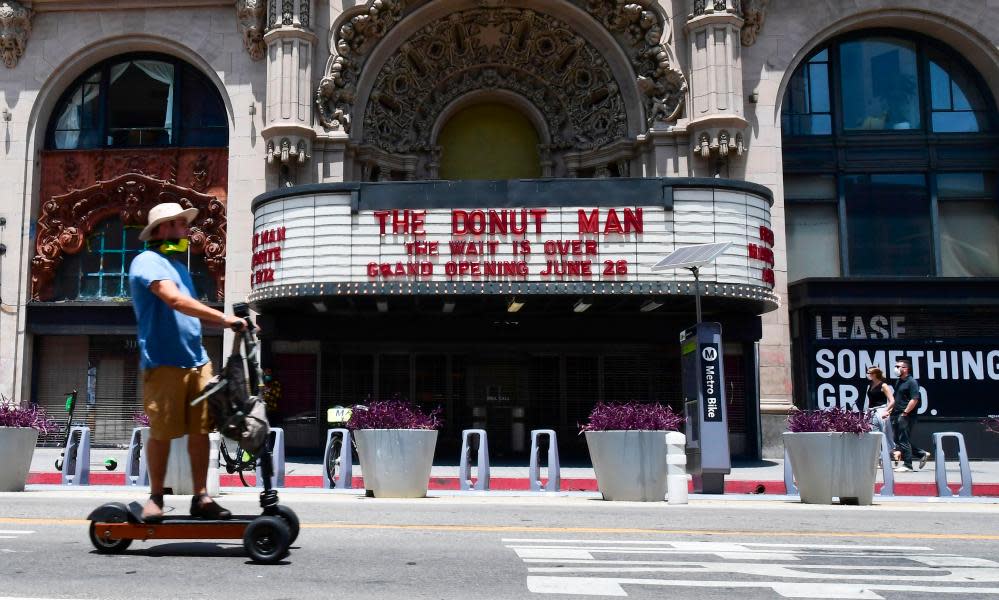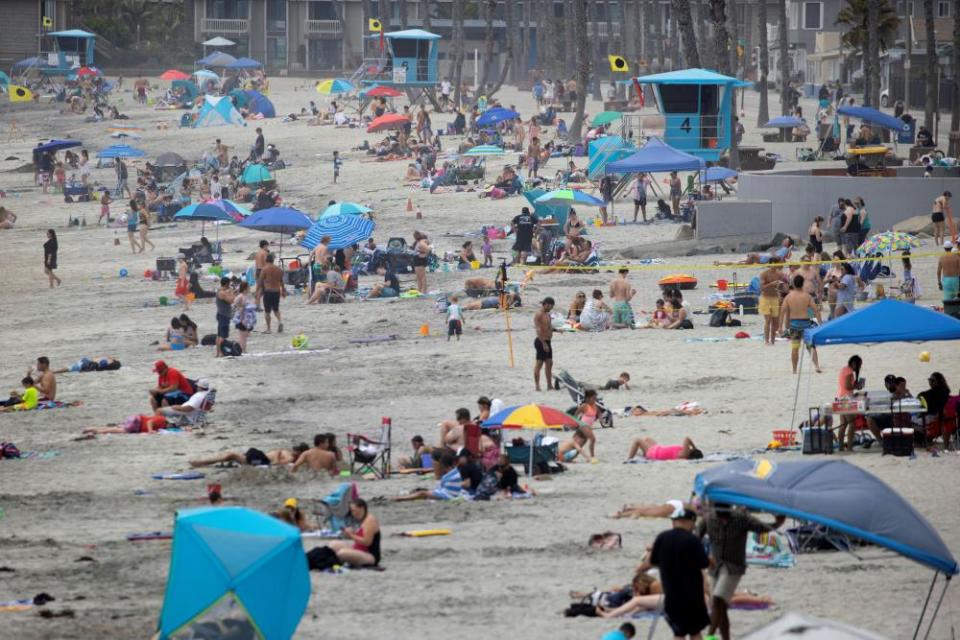Why are California's Covid-19 cases surging? Here's what we know

California’s early, aggressive response to the coronavirus pandemic had earned praise from the top US health officials, and even Donald Trump. But after avoiding the scenarios faced by New York and New Jersey, the state has seen infections and hospitalizations swell in recent weeks.
As malls, museums, bars and other public spaces reopened, Governor Gavin Newsom has urged citizens to wear masks and keep their distance from one another to slow the spread of disease. “I cannot impress upon people more the importance at this critical juncture,” he said, “to take seriously this moment.”
Related: More than 20m Americans could have contracted Covid-19, experts say
Here’s what we know about the situation.
How big is the coronavirus surge in California?
Big. Overall, the state has reported more than 195,500 cases since the pandemic first struck, with 5,700 deaths. California marked a record 7,149 people who tested positive on Tuesday, a figure that dropped on Wednesday to 5,349.
“Part of the surge we’re seeing is due to increased testing,” said Dr Lee Riley, an epidemiologist at the University of California, Berkeley. California has tested roughly 3.7 million people since the beginning of the pandemic, and more than 101,000 tests were processed on Wednesday.
“But the fact that the number of hospitalizations are also increasing means that there’s more going on,” Riley said. As of Thursday, the number of patients hospitalized with Covid-19 is 32% higher than it was two weeks ago, Newsom reported. The number of patients in intensive care also increased 19% over the past fortnight – more than a third of ICU beds available across the state are now occupied by coronavirus patients. Over the past two weeks, about 64 people have died of the virus each day.
“I think pretty much every place has rushed to reopen,” said Dr Anne Rimoin, an epidemiologist at UC Los Angeles. “And as we reopen, of course we’re going to see more cases.”
Where are infections surging?
The number of cases appear to be increasing throughout the state, but the biggest surges in infections are in Los Angeles county and other parts of southern California.
Los Angeles now has more cases than anywhere else in the country, with more than 89,600 infections reported, according to the Johns Hopkins tracker. Rural communities like Imperial county, at the US-Mexico border, and Stanislaus, in the Central Valley, are also seeing surges in both the total number of cases recorded and the proportion of residents who are testing positive.
Bay Area communities – including Santa Clara county, the first in the nation to enact a shelter-in-place order – are also seeing surges, though the proportion of positive tests in the region remains far below the state average.
Officials have attributed the surge in some parts of the Bay Area to workplaces, including an outbreak at a waste management company in Marin county. Since mid-May, outbreaks at prisons have been excluded from the state’s Covid-19 tracking data, but it is worth noting that a devastating outbreak at San Quentin state prison, where an inmate transfer led to more than 500 new cases, and outbreaks at other facilities across the state would add about 850 more new cases logged in the past two weeks to the state’s totals.

Why are infections surging?
It’s not totally clear, though public health experts and officials blame large gatherings where people are not wearing masks and not maintaining a 6ft-radius, even as adherence to these safety measures becomes increasingly political.
“There’s a group of people who go around bragging that they’re practicing individual freedom by not wearing masks,” Riley said. “These people are not practicing freedom – they’re practicing pure selfishness.”
While reopening society can never be risk free, Riley said that countries that have been most successful at containing the virus have been far more vigilant than California in mandating mask-wearing, hygiene and physical distancing. In South Korea, where fewer than 300 people have died despite reporting more cases in February than any country besides China, a second wave of infections has remained relatively small despite restaurants, schools and even nightclubs reopening, Riley noted. “Small clusters of cases are much easier to contain by isolating those who are infected, notifying those who are exposed,” he said. “What we’re seeing in California is a lost opportunity to reopen carefully.”
An uptick in the number of cases among young people is also a concern, Riley said. While people in their 20s, 30s and 40s are less likely to die from Covid-19, they can get seriously ill, and they “can be sources of infection for older people who are most at risk: their grandmas, their grandpas, their buds with diabetes and their friends with high blood pressure”. Healthy young people who show few symptoms could pass the virus on to those who are most at risk of suffering complications.
What will this mean for re-opening?
In order to safely reopen, no more than 5% of everyone in a community who gets tested for Covid-19 should receive a positive result, according to the World Health Organization.
Related: 'We're in uncharted territory': coronavirus and wildfire risks collide in California
California’s threshold for reopening is that no more than 8% of all tests should come back positive. While the positivity rate for the state overall hovers at a tenuous 5.1%, the rate in some southern California counties is nearly 9% or higher.
Governor Newsom said the state might have to “revert back” to tougher restrictions if the situation gets worse.
What do doctors want Californians to know?
Officials and health experts are pleading with Californians to continue to wear masks, wash hands, and stay 6ft apart. Health agencies in some counties are encouraging residents to keep their social circles small – limited to “bubbles” of no more than a dozen friends – and gather outdoors.
In Imperial county, which borders Mexico and Arizona, defiance of a statewide mandate to wear face masks and lax social distancing appears to have exacerbated a crisis both within and across state and national borders. “Whether people here brought infections to Yuma, Arizona and Mexicali, or whether they brought it back from those places is kind of immaterial at this point,” said Dr Thomas Henderson, director of the Imperial County Medical Society. “What we’re seeing here is craziness.”
The crisis has overwhelmed local hospitals, he said. “It’s just a horrible time to be a physician” he added, because doctors have found themselves pleading with the community to wear masks and stay safe, “but it’s all become so political”.
As Donald Trump and rightwing politicians and media outlets derided masks as unnecessary, Dr Anthony Fauci, the health official leading the US response to coronavirus, told Californians who were skeptical of covering their faces in public to “forget the politics. Look at the data.” A string of new research released this summer suggests that masks can reduce the risks of spreading the virus, even if they’re far from foolproof.
“It’s totally understandable to want to get back as quickly as possible to what you perceive as normal in your life,” Fauci said at an event hosted by the Sacramento Press Club. But he urged Californians to stay vigilant, nothing that reopening isn’t “black or white, either no restrictions or locked down”.

